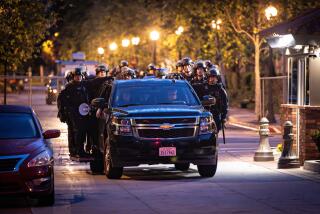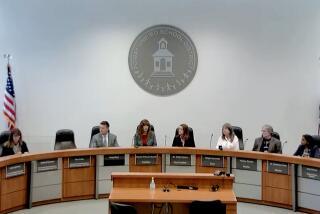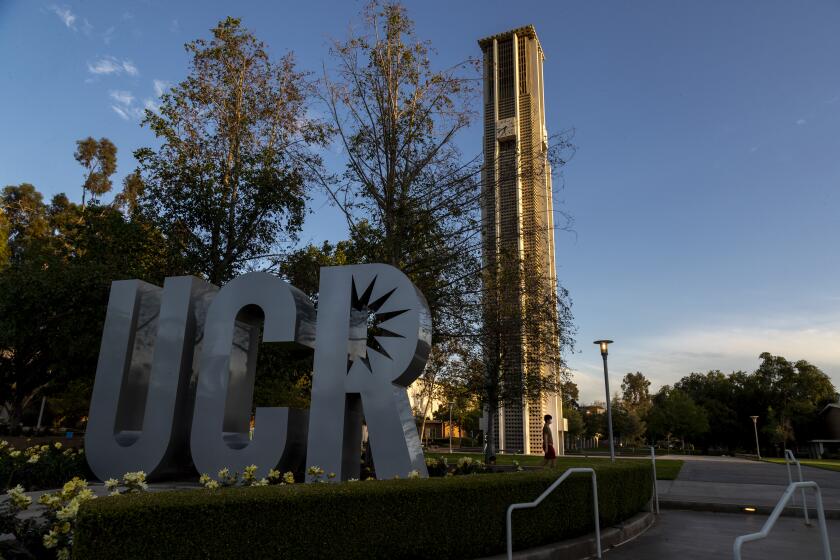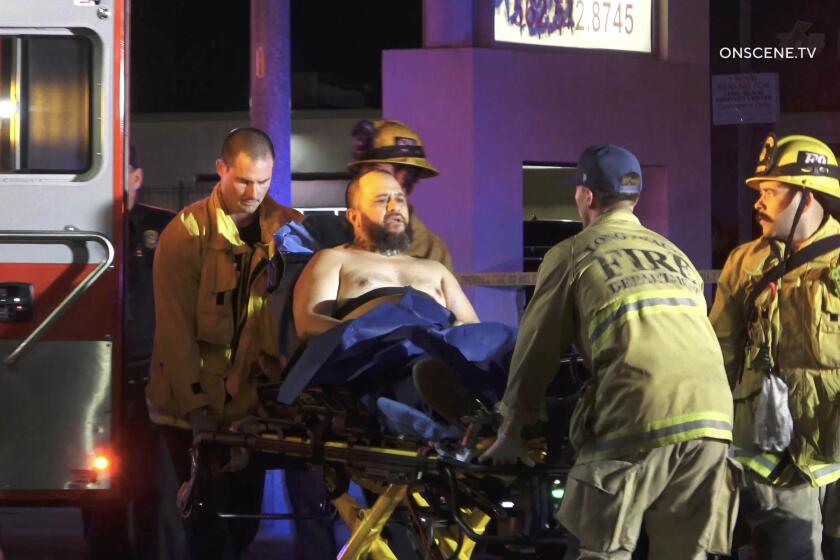Claim of Poisoning Stirs Debate on ‘Mayhem Manuals’
Oleander is a familiar sight to Southern Californians. A dark green shrub with pink, red or white flowers, it brightens up freeway landscapes and sprouts gaily in suburban back yards.
What is not as well known is that every inch of this photogenic plant harbors a hard-to-detect and potentially fatal poison for which there is no sure antidote.
Kurt Saxon knows. He wrote about the lethal properties of oleander in a sinister 1971 book called “The Poor Man’s James Bond.” The self-published text, which law enforcement officials have long deplored, tells readers how to kill people, commit arson and build bombs.
Earlier this year, both the ancient plant and the atomic-age book came under new scrutiny after witnesses at a preliminary hearing testified that Pasadena funeral home operator David Sconce said he had poisoned Burbank mortician Timothy Waters.
Waters, 24, died April 8, 1985, at Camarillo’s Pleasant Valley Hospital. Until May, when toxicological tests turned up traces of oleander in Waters’ blood and tissue, it had been thought that the 300-pound mortician died of natural causes brought on by obesity.
The Ventura County district attorney’s office is reviewing the new evidence but has not determined whether to charge the 32-year-old Sconce in Waters’ death. Sconce is awaiting trial in Pasadena Superior Court along with his parents, Jerry and Laurieanne Lamb Sconce, on 67 felony and misdemeanor charges regarding the operation of Lamb Funeral Home in Pasadena.
The charges range from mutilating corpses to selling body parts. David Sconce also faces charges of soliciting the murders of his grandparents and of a deputy district attorney who was the prosecutor in the preliminary hearing. The Sconces have denied all the charges.
Quest for Information
Nonetheless, the revelation of death by poisoning sent coroners, prosecutors and police investigators scurrying to learn more about the 12 or so known cases of oleander poisoning and to obtain copies of “The Poor Man’s James Bond,” which is not widely available but is stocked in some survivalist shops.
It also raised concerns that texts such as Saxon’s could prove dangerous in the hands of violent, mentally unstable individuals and sparked debate on censorship vs. freedom of the press.
Neil Livingstone, a Georgetown University professor who wrote “The War Against Terrorism,” called Saxon’s book “an atrocious piece of literature that serves no public interest.” He wants it banned.
“Kurt’s books teach people how to kill cops and teach children how to blow themselves up,” he added. “I don’t think the First Amendment ought to protect you if you write a book on how to murder someone.”
Law enforcement officials dub books such as Saxon’s “mayhem manuals” and say they often find such texts when they raid illegal explosives labs, drug labs and terrorist hide-outs. Although it is difficult to tie violent incidents directly to the books, police psychologists say the manuals are dangerous because they encourage disturbed people to act out paranoid rage and murder fantasies.
Lt. Don Beasley, who heads the Los Angeles Police Department’s explosives squad, says criminals often photocopy and pass around pages of “The Poor Man’s James Bond” and “The Anarchist Cookbook,” another such tome that was popular in the 1960s.
The police say danger also arises because the books occasionally print inaccurate chemical formulas or do not indicate proper safety procedures. Livingstone said this is especially true of “The Poor Man’s James Bond.”
“We get an average of six kids a year who blow themselves up, and when we get to their house, we always find these manuals,” said San Diego County Sheriff’s Sgt. Conrad Grayson of the bomb and arson squad.
Last year, the squad raided an Escondido house after a 17-year-old boy blew himself up with homemade explosives. Ten pipe bombs and a how-to text titled “Improvised Munitions Black Book” were found.
Even those most staunchly committed to press freedom and the public’s right to bear arms recoil at some aspects of Saxon’s book, which includes a chatty section on how to test homemade poison concoctions on homeless winos.
“That’s pretty sick,” said Jim Graves, managing editor of Soldier of Fortune, the guns-and-adventure magazine.
Saxon claims his book has sold 60,000 copies, many via mail order. Few mainstream bookstores stock “The Poor Man’s James Bond”; some bookshop owners interviewed say they don’t want it on their shelves.
‘Russians and Martians’
“I’m torn two ways. It’s a free speech issue on one hand and deplorable on the other,” said Dosier Hammond, the former president of the Southern California Booksellers’ Assn. and the trade-book manager at the UCLA student bookstore, which does not carry the book.
Saxon, a folksy 56-year-old who lives in Harrison, Ark., and publishes survivalist books says with glee that his book will come in handy “when the Russians and Martians invade.”
When asked about the Camarillo death, Saxon responded: “It’s not my fault. Open any book on poison and you’ll find the same thing.”
Saxon has deleted the oleander poison entry in his “New Improved Poor Man’s James Bond” because, he said, “it wasn’t fanciful enough.”
The section originally read: “Oleanders are common flowers but are about as poisonous as any plant. The heart is affected very quickly and severely. Both the branches and the leaves are lethal.”
Experts say only a fraction of oleander poisonings, whether accidental or intentional homicides, are reported. Dr. Fredric Rieders, a forensic toxicologist with National Medical Services in Philadelphia, said children, in particular, are susceptible to oleander poisoning because they put things in their mouths.
Rieders said symptoms include vomiting, diarrhea, indigestion and a contracting of the heart until the muscle cramps cause the blood to stop flowing, which can result in death.
“Once the poisoning has occurred, it is extremely difficult to counteract it. It is mostly in God’s hands,” Rieders said.
A minuscule amount of the plant is enough to be fatal, experts said.
Dr. F. Warren Lovell, Ventura County’s coroner, says he knows of two oleander poisoning cases--one in which a 96-year-old woman in Northern California committed suicide by eating oleander leaves and a case in which a Haitian herb doctor in Florida prescribed oleander tea for ailing patients and accidentally killed one.
Then there are the unconfirmed tales, such as the one about the Boy Scout who barbecued a wiener on an oleander branch and died.
Waters, who ran the Burbank-based Alpha Society, a cremation service, died in agony after two days of bloody vomiting and diarrhea at the Camarillo house of his mother, Mary Lou Waters. An autopsy performed by the Ventura County Coroner’s office said Waters died of natural causes, compounded by his extreme obesity and fatty deposits in his liver.
Some authorities today question that conclusion and say the coroner should have carried out toxicological tests.
“The autopsy looked real funny to me,” said Walt Lewis, the deputy district attorney in Pasadena who initially handled the Sconce case, but was removed after Sconce was accused of soliciting his slaying.
“Here’s a guy who’s 24 and weighs 300 pounds, and he died of fatty deposits in the liver?” Lewis asked rhetorically.
Lovell, who became Ventura County’s coroner in late 1985, said the previous coroner indicated he planned to perform toxicological tests. But Lovell said he left the post in July, 1985, without doing so.
Both Lovell and others point out that standard toxicological tests would not have turned up the presence of oleander, however, because it requires a specific test.
“If you don’t suspect oleander, it would be way down on your list of things to look for,” Rieders said.
It wasn’t until this year that the authorities began to suspect foul play. During an 8-month hearing in Pasadena Superior Court, witnesses testified that Sconce hired two men to beat up Waters on Feb. 12, 1985.
David Edwards, a former Lamb employee, testified that Sconce borrowed the Saxon book to learn how to poison a neighbor’s dog.
Witnesses said that in March Sconce went to a Simi Valley restaurant where Waters was eating and told witnesses that he dropped poison into Waters’ mixed drink when he left the table.
The motive, according to witnesses, was that Sconce wanted to silence Waters because the Burbank mortician suspected that Lamb Funeral Home was conducting illegal, multiple cremations.
One cellmate testified that the poison was not strong enough, so Sconce poisoned Waters again, causing a heart attack. Cellmates testified that Sconce bragged about poisoning Waters.
The Ventura County district attorney’s office said it probably will not decide whether to file murder charges against Sconce until September, because the prosecutor is on vacation.
More to Read
Start your day right
Sign up for Essential California for news, features and recommendations from the L.A. Times and beyond in your inbox six days a week.
You may occasionally receive promotional content from the Los Angeles Times.





